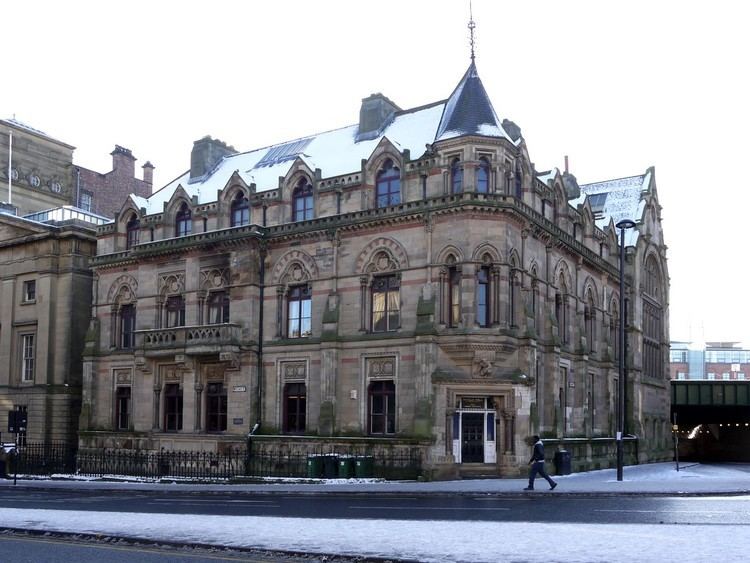 | ||
The North of England Institute of Mining and Mechanical Engineers (NEIMME), commonly known as The Mining Institute, is a British organisation dedicated to the research and preservation of knowledge relating to mining and mechanical engineering. Founded in 1852, the institute, in Newcastle upon Tyne, possesses one of the largest collections of such mining information in the world. Its library, named after the first President Nicholas Wood contains more than twenty thousand volumes of technical literature, in the fields of mining, geology, mechanical engineering, government blue books, mine rescue, mineralogy, mineral chemistry, mining statistics, mining law, seismology and other related topics.
Contents
Background
The origins of the institute stem from William Turner, minister of the Hanover Square Chapel, just behind the position of Newcastle Central Station. He began Newcastle's first Sunday School, 'a focus of light and learning' for the town. One of his students, John Buddle, became a wealthy landowner, and member of the Literary and Philosophical Society and the Natural History Society of Northumberland, Durham and Newcastle upon Tyne (now the Natural History Society of Northumbria). Buddle became a major influence on the Durham and Northumberland Coalfield, "the King of the Coal Trade". In 1816, Buddle devised a system of diverting underground ventilating currents that is in use today. He did not live to see the impact of his legacy, as he died in 1843, nine years before the founding of the North of England Institution. His papers and 'place books' were deposited at the institute.
Following an explosion at Felling in 1812, the Sunderland Society was set up to improve safety where gas was present in mines. The committee secured the services of Sir Humphry Davy, inventor of the safety lamp, in 1815. Despite changes, explosions continued, culminating in a devastating explosion at St Hilda Colliery in which 52 persons were killed. The South Shields Committee recommended the introduction of government inspections of mines the education of mechanical engineers, leading to the first Government Inspection Act of 1850. A coroner's court held at the Mill Inn at Seaham in 1852 suggested it would be advantageous to form a society to consider the prevention of accidents in coal mines.
A meeting of the Literary and Philosophical Society on 3 July 1852 proposed forming a society to discuss the ventilation of coalmines, prevention of accidents and other items connected with the general working of coalmines. It was to be called "The North of England Society for the Prevention of Accidents and for other purposes connected with mining", and Nicholas Wood would be chairman. The title actually adopted was the North of England Institute of Mining Engineers, changed in 1870 to North of England Institute of Mining and Mechanical Engineers. A committee was appointed to draw up rules and the inaugural meeting was held on 3 September 1852 at which Wood delivered the inaugural address at the lecture theatre of the Literary and Philosophical Society. The institution determined "to endeavour if possible, to devise measures which may alert or alleviate those dreadful calamities, which have so frequently produced such destruction of life and property" and "to establish a literary institution, more particularly applicable to the theory, art and practise of Mining".
Wood was president from the institute's inauguration in 1852 until 19 December 1865 when he died aged 70. Robert Stephenson, son of George Stephenson, a colleague and contemporary of Nicholas Wood, was his pupil at Killingworth Colliery and when Robert Stephenson died in October 1859 he left £2000 to the Institute which started a fund to build its permanent home.
A School of Medicine founded in 1834, a predecessor of Newcastle University, occupied the site the institute was built on. The College of Physical Science was founded 1871 and one of its early supporters was institute president Edward Fenwick Boyd. its classes were taught in the institute's lecture theatre. It was renamed Armstrong College and was for many decades part of the University of Durham.
Architecture
The North of England Institute of Mining and Mechanical Engineers was built in Grainger's new town on the site of the medical school on land traditionally held by the Dukes of Westmoreland, the Nevilles. The library hall was commissioned and built in 1872 to the design of Archibald Matthias Dunn, whose father, mining engineer Matthias Dunn, had been present at the institute's inaugural meeting. It was built at the height of the English Gothic Revival with high windows and a sky lit barrel-vaulted ceiling, showing a mixture of gothic and Tyneside Classical themes. Inside the building is a monumental statue of Nicholas Wood mounted on a throne in the setting of an iconstasis. There are other works of art including marble busts of John Buddle and Thomas Foster, the institute's second president.
Collections
The collections include books, tracts, maps, photographs, archives, periodicals, artworks and the institute has a searchable catalogue. As other institutions closed, their libraries have transferred to the Institute including those from the Centre for Lifelong Learning, University of Newcastle, Coal Research Establishment from Stoke Orchard by Cheltenham and elements from the Bretby Mining Research Establishment.
Music
In recent years the main hall of the Institute has also been used as a 100-capacity music venue, predominantly by local bands. The space has been described as "brilliantly atmospheric", and "an intimate setting for live music". The Mining Institute has also been used as a venue for Home Gathering Festival.
